WSU Interview with Alan Duffy Woods Bagot
24 . 04 . 2017
Western Sydney University Fit Out
Interview with Alan J Duffy (Woods Bagot Regional Education Sector Leader)
A new philosophy for learning, collaborating and sharing inspired the design and fit-out of Western Sydney University’s new Parramatta campus. Designed by Woods Bagot, the facility focuses on creating a social environment where people can connect with each other in serendipitous ways.
Planex was engaged to design customised lockers that addressed multiple requirements of storage, aesthetics and existing joinery. With unique experience catering specifically to the evolving workplace, Planex was able to respond to the brief with a customised, flexible solution.
Can you tell us a little bit about the design philosophy that inspired the WSU project?
We were asked to create a flexible, adaptable learning environment in a high-rise building that had been designed as a commercial building for workplace. WSU wanted to explore a vertical campus model, so from a design perspective, we needed to respond in agile ways to how WSU wanted to occupy the building.
The building accommodation changed from the School of Law to the School of Business and the School of Engineering, which all had very different needs for their educational environments. The result was an adaptable approach for learning spaces that could accommodate any faculty, with a focus on integrating technology and improving collaboration. For us as designers, it was about creating a learning experience for the students, where it is exciting as well as educational.
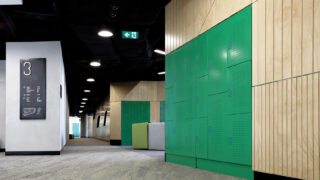
Why was the concept of connection so critical to the building brief?
WSU is one of the first vertical University campus designs in the NSW tertiary education sector. With taller buildings comes the issue of access between many floors stacked on top of each other. Successful connection between floors is a fundamental requirement for a successful vertical campus.
At WSU a continuous void and generous staircase connect every floor to enable visual sight and physical access across eight levels. This allows for more opportunities for people to interact throughout the building, creating opportunities for discovery by providing a social environment where individuals can connect with each other.

How does the WSU educational environment differ to traditional university learning spaces?
The University coined the phrase ‘agnostic’ to describe the need for non-faculty specific learning spaces. This enabled us to test pedagogy in a way that we hadn’t done before and provide an even split between formal and informal learning environments throughout the building offering a more diverse learning experience.
Embracing technology also allows students to customise and transform learning areas to suit their individual needs. Through the use of colour, flexible working areas, adaptable furniture, charging stations for devices, high-speed internet, projectors and improved audio/visual infrastructure, we were able to support a strong learning environment.
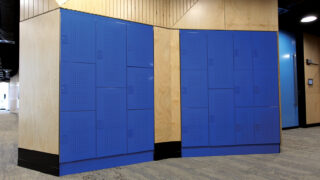
What design considerations were important when creating collaborative environments and ‘activated’ spaces?
Collaboration is all about having opportunities to share ideas. We like to call the WSU classrooms ‘active or flipped classrooms’. A flipped classroom is where students study online content before they arrive to class so that the classroom becomes an immersive experience where one can apply the knowledge they have already learned prior. We ended up calling these rooms “studios” during the design process, which better reflected the collaborative activities within them.
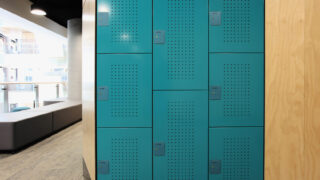
How does the environment promote collaboration?
We deliberately approached the formal spaces as physical objects that could define space on any given floor plate. We could then express these objects through materiality and form. We used routed plywood as the skin for these studio pods, which added a natural material to the interior finishes and a grounding element to the large floor plates.
By activating the edges of the studios with multiple uses such as storage we’ve introduced a variety of opportunities for social engagement between students and academics, breaking down traditional barriers in tertiary buildings. This is fantastic for peer-to-peer interaction but also the serendipity that comes with spontaneously meeting for a conversation or bumping into an academic at a locker wall.
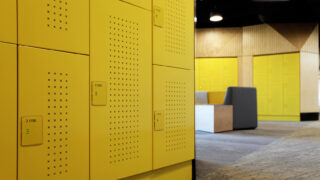
Do these new ways of working really support the future of the workplace?
As Architects, we’re trying to design learning environments that assist students to transition into the commercial world, as prepared as possible. A lot of universities grapple with the problem of how to do this. How are students prepared to excel in an evolving working environment beyond the University?
Technology has enabled different ways of working at WSU and influenced the learning settings. Especially providing the opportunities to learn through conversation rather than from instruction or didactic means, which is the older traditional way. This also better reflects what is happening in local industry and commerce. These social interactions are encouraged through the design of more ‘spaces in between’ the informal settings, just like the café or restaurant settings often provide a place for successful business encounters beyond the campus environment.
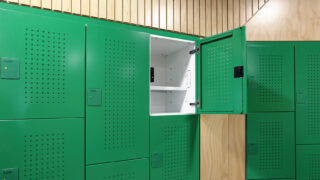
How did the storage specified reflect the need for ‘active’ spaces?
We wanted to break down the formal boundaries that typically exist within an institution to make the space more playful and inclusive. Walls within the educational environments can sometimes be viewed as barriers. To shift this perception we ‘activated’ the walls of the different building components. This included locker storage, where students can keep their belongings in a safe and secure place while they are spending time on campus.
Technology has allowed for better mobility and different ways of learning. This has also led to students carrying more mobile devices such as laptops, tablets and phones, which need to be stored safely at certain times during a day on campus. Lockers are a great solution to this problem. As the locker walls are frequently used, this increases chance encounters and opportunity to bump into staff and other students informal meetings.
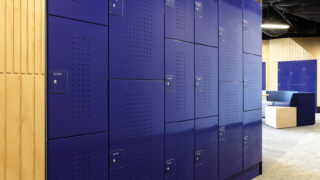
Was there any benefit to specifying local manufacturers on the project?
When collaborating on projects we try to work with local people as much as possible. Especially with the Parramatta project because of the long-term strategic plans for growth. Our evidence-based design approach led us to talking with local suppliers such as Planex and Gantner who could offer the right solutions.
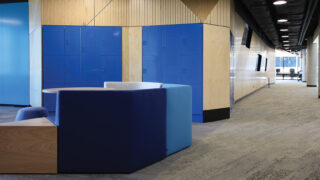
What types of ergonomic considerations did you make during the planning stages?
When we look at collaborative environments, choice and diversity are two key success factors. For people to learn in different ways you need to provide a variety of settings and diverse places where they feel comfortable with the choice to move and explore the space.
Workplace floors needed the ergonomic requirement for students to sit for extended periods but also the opportunity to shift away from tasks to meet and collaborate with fellow peers. For example if you sit on an armchair you’ll react to someone very differently than if you’re sitting in a task chair, so there are definitely correlations been the design of space and how people behave.

How important was flexibility to the overall design?
Flexibility was important to us. Universities needs are changing quickly as technology advances. So we introduced adaptable and adaptive design principles allowing for an adaptable approach over time and an adaptive approach to things like furniture, settings and technology, which can happen instantly and allow for different learning outcomes within a single room by re-arranging the settings. Flexibility is a key success factor for collaborative environments.
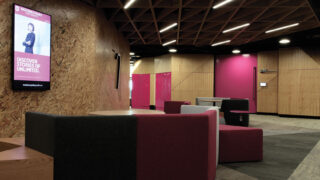
See the product page for more information on xLocker2 or download the latest locker case study.
